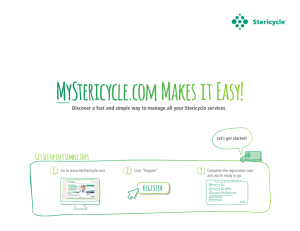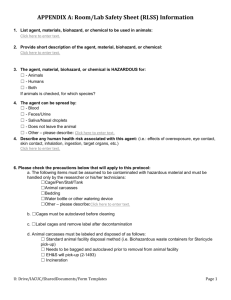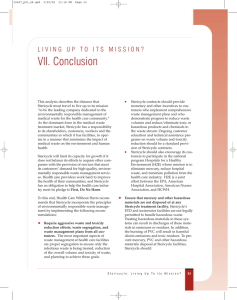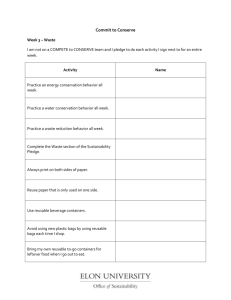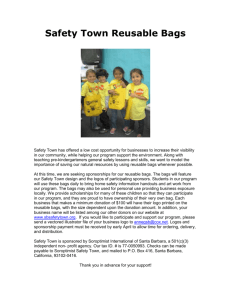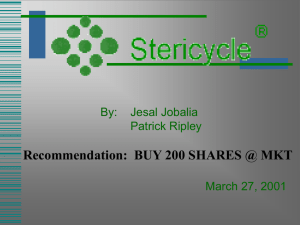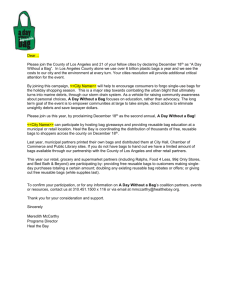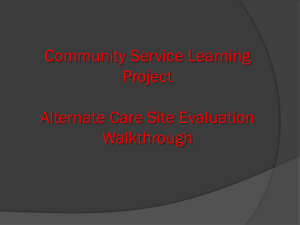christensen_buckhorn..
advertisement
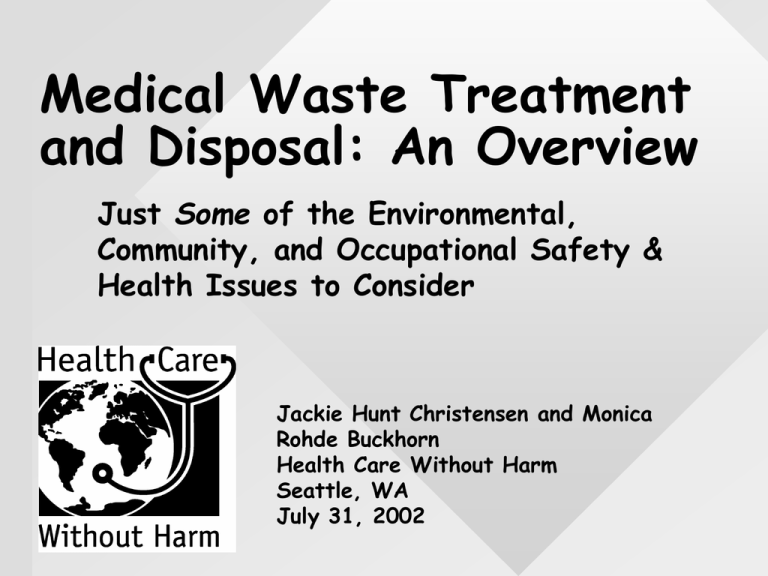
Medical Waste Treatment and Disposal: An Overview Just Some of the Environmental, Community, and Occupational Safety & Health Issues to Consider Jackie Hunt Christensen and Monica Rohde Buckhorn Health Care Without Harm Seattle, WA July 31, 2002 The Mission of Health Care Without Harm To transform the health care industry so it is no longer a source of environmental harm by eliminating pollution in health care practices without compromising safety or care. We will accomplish this mission by: • Promoting pollution prevention. • Supporting environmentally safe materials, technology and products. • Educating and informing about the environmental and public health impacts of the health care industry and solutions to its problems. Why work on medical waste? • Medical Waste Incinerators = Major sources of dioxin & mercury • Ethics: Physicians’ oath to “First, do no harm” • Irony that the place people go to be healed could be making them sick Problems with Hospital Waste • Toxicity - Dioxin (from PVC and other chlorinated items) - Mercury and other heavy metals • Increasing Volume - Large amounts of single-use, disposable items - Recycling not being utilized in many cases Why is HCWH Opposed to Incineration? MWIs = 3rd largest known source of U.S. dioxin air emissions, produce about 10% of U.S. mercury emissions Incineration produces both toxic air emissions and toxic ash residue. Burning medical waste actually creates new toxic compounds such as dioxins. Why is HCWH Opposed to Incineration? Many MWIS also burn readily recyclable items. Wastes with high energy value, such as plastics, may contain chlorine & contribute to dioxin formation. Most Hospital Waste Is Simply “Trash” Regulated Medical Waste 10% Includes 2% pathological waste Hospital Waste (Trash) 85% Hazardous Waste 5% Hospital Waste, Like Household Trash, Is Largely Recyclable Food Waste 10% Metals 10% Paper & Paperboard 45% Wood 3% Glass 7% Other 10% Plastics 15% Some Problem Products • Polyvinyl chloride (PVC) plastic materials • Mercury-containing products • Cadmium-containing red bags & sharps containers • Chlorine-bleached paper products & packaging • Pesticides used in and around HC facilities How to Address Problem Products? • Waste Management approach: Recycle/reuse products • Pollution Prevention approach: Avoid purchasing problem products in the first place PVC in Medical Products • IV bags • Rigid packaging trays • Blood bags • Mattress covers • IV and respiratory therapy tubing • X-Ray folder holders • Venodyne sleeves • Patient ID cards • Water bed liners • Shower curtains • Dialysis bags • Thermal blankets PVC Alternatives • Non-PVC IV Bags (e.g., McGaw Bags ) • Non-PVC blood bags (under development) • Non-PVC Sharps containers (e.g., reusable polyethylene • Non-PVC tubing • Non-PVC ID bands • Non-PVC suction liners • Nitrile gloves (Instead of vinyl or latex) Mercury-Containing Products and Their Alternatives Product – Hg batteries – Esophageal devices, Cantor & MillerAbbott tubes – Hg thermometers Alternatives – Lithium, zinc air, alkaline – Products w/ tungsten tubing Anderson AN-20 – Digital, expansion or aneroid Mercury-Containing Products and Their Alternatives Product: – Hg-based blood pressure monitoring devices – Lamps & lighting devices – Hg switches – Hg dental amalgams Alternative: – Electronic vacuum gauge, expansion or aneroid – Non-Hg basedsodium vapor,glow lights, optical – Non-Hg switches – Gold, ceramic, porcelain Opportunities for Reuse in Health Care • Built-in eggcrate mattresses • Reusable interoffice mailers • Reusable dishware and cutlery • Plastic or steel emesis and wash basins • Reusable cloth underpads Opportunities for Reuse in Health Care • Reusable personal protection gowns • Double-sided copies • Reusable respiratory therapy equipment • Rechargeable batteries • Reusable packaging units -- tubs, totes, sharps containers What about the rest?? Treating “Red Bag” Waste • 10-15% of health care waste is “regulated medical waste (RMW);” a small fraction of that is pathological waste • RMW generated can vary widely be facility type Treating Regulated Medical Waste • Contrary to popular belief, the Centers for Disease Control and Prevention does not REQUIRE incineration for either RMW or pathological waste • A few individual states require incineration of path waste or chemo Questions to Ask Before Choosing Treatment Technology • Has your facility done a waste audit? • What measures are staff already taking to minimize amount & toxicity of waste? • Does your facility have staff, expertise & space to allow for onsite technology? • What are your state’s regulations re: onsite treatment? • How long has treatment technology been in use? Where? (any comparable facilities?) • What is the estimated life of the equipment? More Questions to Ask … • Cost: have you factored in utilities, down time for repairs, cost of alternate treatment during down time, permitting, tipping fees, supplies, etc.? • Emissions: what are the known emissions to air, water, land from this technology? Which pollutants are regulated? • What is the reputation of the technology company? • Have you involved the local community in the decisionmaking process (for both on- and offsite), and if so, how? • What contract conditions are negotiable? Choosing Treatment Options • There is no “magic box” to make all waste & liability disappear • Facilities may need to utilize more than one type of technology • Involve diverse group of stakeholders, including local community On-Site Treatment Options • Autoclave • Microwave • Chemical treatment • All have risks and benefits • Costs vary by size of treatment unit, supplies, reliability of equipment, ease of operation, etc. If You Opt for Off-Site Treatment … For many hospital waste treatment services, from sharps to regulated medical waste, your facility may have only one choice nearby: Stericycle Off-site treatment: Stericycle • For most health care facilities, Stericycle is “the only game in town” for off-site treatment for RMW • HCWH is working to make sure that Stericycle lives up to its mission -- To be the leading company dedicated to the environmentally responsible management of infection control and compliance services for the healthcare community Stericycle: #1 Commercial Medwaste Treatment Provider • 11 times the size of its nearest competitor, Med/Waste Inc., which filed for bankruptcy earlier this yea r • Worth $620.6 million in assets as of January 2002 • Bought Browning-Ferris Industries’ medwaste assets in 1999 Stericycle: Medical Waste Giant • Purchase of BFI assets moved Stericycle from small company using alternative technology (“electrothermal deactivation”) to big company with many commercial medical waste incinerators Community Opposition to Stericycle Facilities • Saint Louis, Missouri • Gila River Indian Community, Arizona • Haw River, North Carolina Stericycle’s Worker Health & Safety Performance • Woonsocket, RI – OSHA alleged Stericycle mishandled pathological waste at ETD facility, knowingly exposing workers to potentially dangerous pathogens • Company paid $400,000 in fines for falsification of data, failure to treat waste properly, failure to sterilize RMW containers & improper use of equipment More Worker Health & Safety Issues • Morton, WA – Three workers at ETD facility developed tuberculosis between May and September, 1997 • Washington State OSHA fined Stericycle $1,100 for serious violations. NIOSH investigated as well. Stericycle claims that any problems identified by regulators have been fixed. Practicing Dioxinand Mercury-Free Medicine • Environmentally sound procurement policies • Minimization of packaging • Reusables instead of disposables • Recycling • Ongoing “Red Bag” reduction education • Waste segregation • Non-incineration treatment technologies for all wastes HCWH Resources for Treatment Technology Discussions • Medical Waste Treatment Technologies: Evaluating Non-Incineration Alternatives. A Tool for Health Care Staff and Concerned Community Members • Non-Incineration Medical Waste Treatment Technologies: A Resource for Hospital Administrators, Facility Managers, Health Care Professionals, Environmental Advocates, and Community Members • Available through www.noharm.org Resources for Health Care Facilities: – Health Care Without Harm www.noharm.org or 202-234-0091 – Hospitals for a Healthy Environment www.h2eonline.org or Laura Brannen laura.brannen@valley.net – Sustainable Hospitals Project (UMASS Lowell) www.sustainablehospitals.org or Catherine Galligan: 978-934-338 or shp@uml.edu
